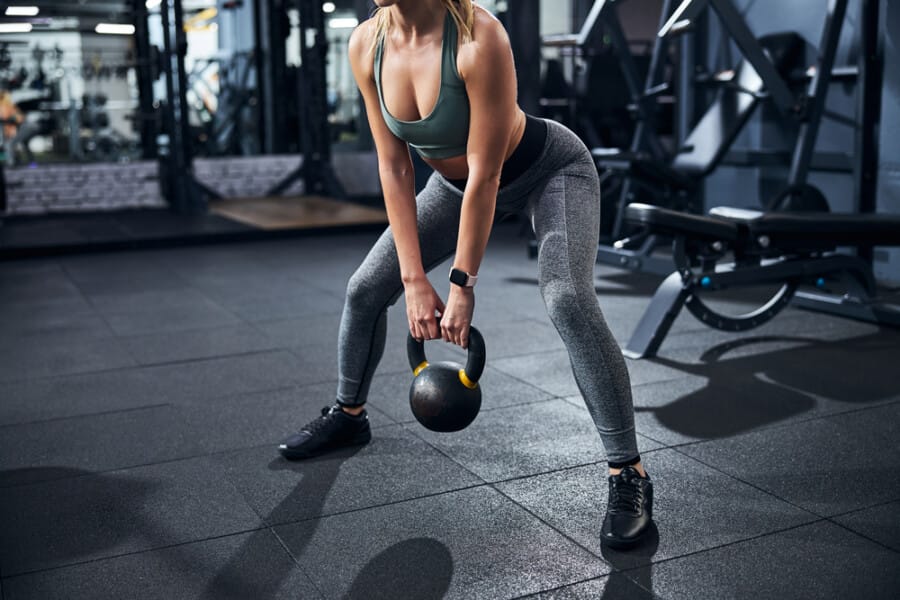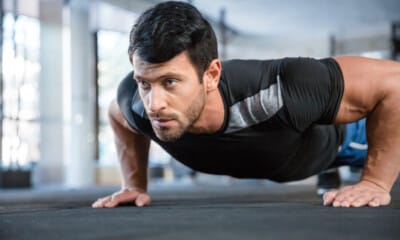All You Need To Know About Sumo Squats
Sumo squats are a highly effective exercise for strengthening and shaping your glutes and inner thighs, as well as enhancing hip flexibility. By making slight adjustments to the traditional squat stance, the sumo squat engages your muscles in a unique way, offering significant benefits when incorporated into your fitness regimen.
The sumo squat earns its name from the resemblance to the stance of a traditional sumo wrestler.
“This variation involves a wider stance with the feet turned outward, setting it apart from the standard squat,” explains Joey Thurman, CPT, a certified personal trainer, author, and founder of Fun Fitness Bros. “The sumo squat is particularly beneficial for individuals aiming to boost their lower-body strength.”
Whether you are a novice or an experienced squatter, there are various sumo squat variations to challenge your body.
“It’s often done with a weight positioned near the shins or feet. The additional weight can help achieve greater depth due to the open hip position and the downward pull of the weight,” adds Thurman.
Maintaining proper form is crucial to maximize benefits and avoid injuries. Let’s begin by understanding how to perform the sumo squat correctly, followed by details on the muscles worked, advantages, common errors, and alternative variations to attempt.
How to Perform a Sumo Squat with Impeccable Form
Prioritize mastering the correct sumo squat form using just your body weight before introducing additional weight such as a kettlebell, barbell, or dumbbell. If you need a refresher on executing a squat with proper form, we’ve got you covered.
- Position your feet slightly wider than hip-width apart, with arms hanging by your sides.
- Turn your toes out at a 45-degree angle.
- Maintain an upright chest posture, bend your knees, push your hips back, and shift your weight onto your heels as you squat down, as if preparing to sit in a chair.
- Extend your arms forward as you descend into the squat.
- Lower yourself as far as comfortable or until your thighs are parallel to the ground.
- Push through your heels to return to a standing position.
- Repeat for 2 to 3 sets of 8 to 12 repetitions.
Tip: Placing weight plates under your heels (as demonstrated by Thurman) can facilitate achieving a deeper squat depth.
Muscles Targeted by Sumo Squats
“Sumo squats are an effective movement for enhancing leg strength and increasing leg muscle mass,” notes Grayson Wickham, DPT, CSCS, a physical therapist and founder of Movement Vault.
Sumo squats engage the same muscles as traditional squats, with particular emphasis on certain muscles due to the foot positioning.
- Glutes: The gluteal muscles (gluteus maximus, medius, and minimus) are primary targets during sumo squats.
- Adductors: A study from 2021 in the International Journal of Environmental Research and Public Health indicates that sumo squats work the adductor muscles (inner thighs) more effectively than traditional squats due to the wide stance and toe angle.
- Quadriceps: The quadriceps (quads), the large muscles at the front of your thigh, are strengthened during sumo squats, with a focus on the vastus lateralis portion of the muscle based on the International Journal of Environmental Research and Public Health study.
- Hamstrings: These posterior thigh muscles receive significant activation during sumo squats.
- Calves: Your calf muscles play a role in stabilizing your foot and ankle throughout the squat.
- Core: Apart from the lower body, your core muscles work to stabilize your body during sumo squats due to the upright trunk posture.
Advantages of Incorporating Sumo Squats into Your Workout Routine
Discover six compelling reasons why sumo squats should be an integral part of your exercise regime.
1. Strengthening Inner Thighs
“The wider stance and outwardly turned feet in sumo squats engage the adductor muscles of the inner thighs, complementing the glutes and quads activation,” Thurman explains. This is supported by a 2017 study in the Journal of Strength and Conditioning Research.
In addition to targeting the aforementioned muscles, sumo squats also work the hamstrings, calves, and core.
2. Enhancing Hip Mobility
“Sumo squats contribute to improved hip flexibility and range of motion due to the specific hip angle required,” highlights Thurman.
3. Reduced Back Strain
According to Thurman, when performing sumo squats while carrying a weight, the weight is held lower and closer to your body’s center of gravity, minimizing lower back strain compared to other squat variations or when holding the weight higher.
Moreover, sumo squats strengthen core muscles, which provide support for your back and help prevent injuries.
4. Alleviating Ankle Joint Stress
Individuals with limited ankle mobility, whether due to injury or tight calves, may find sumo squats easier on the ankle joint compared to traditional squats.
“The key benefit of sumo squats over standard squats is the reduced demand on ankle mobility, particularly less need for ankle dorsiflexion,” Wickham points out.
5. Functional Exercise
By engaging the same muscles involved in everyday movements such as sitting, standing, walking upstairs, and stepping over obstacles, sumo squats enhance your functional abilities.
The benefits of sumo squats can also extend to sports activities, potentially improving performance in running, jumping, and sports like basketball or tennis.
6. Versatility
“Sumo squats can be executed with various equipment—dumbbells, kettlebells, barbells— or using just your body weight, catering to a wide range of fitness levels,” Thurman emphasizes.
Different Sumo Squat Variations to Add Variety
Once you have mastered the basic sumo squat, experiment with one or more of these alternative sumo squat variations.
1. Weighted Sumo Squat
Incorporate a kettlebell or dumbbell to increase resistance in this exercise. Introducing weight not only intensifies muscle engagement but also promotes deeper squatting, consequently enhancing hip mobility and extending the range of muscle activation, according to Thurman.
- Start by standing with your feet slightly wider than hip-width apart.
- Position your toes outward at a 45-degree angle.
- Hold a kettlebell or dumbbell with both hands in front of you with your arms straight down.
- Keep your chest up, bend your knees, push your hips back, and lower into a squat as if you’re sitting in a chair.
- Lower down until your thighs are parallel to the floor.
- Push through your heels to return to the standing position.
- Repeat for 2 to 3 sets of 8 to 12 reps.
2. Sumo squat with overhead press
This exercise engages your shoulders, back, arms, legs, and core. Begin with a lighter weight and increase gradually.
- Stand with your feet slightly wider than hip-width apart.
- Point your toes outward at a 45-degree angle.
- Hold a dumbbell in each hand near your shoulders with your elbows facing forward.
- Keep your chest up, bend your knees, push your hips back, and lower into a squat as if you’re sitting in a chair.
- Lower down until your thighs are parallel to the floor.
- Push through your heels to stand up and press both arms overhead.
- Return to the starting position.
- Repeat for 2 to 3 sets of 8 to 12 reps.
3. Sumo squat with hop
This variation adds a plyometric element that works your legs, inner thighs, and boosts your heart rate.
- Stand with your feet slightly wider than hip-width apart.
- Position your toes outward at a 45-degree angle.
- Hold a kettlebell or dumbbell with both hands in front of you with your arms straight down.
- Keep your chest up, bend your knees, push your hips back, and lower into a squat as if you’re sitting in a chair.
- Lower down until your thighs are parallel to the floor.
- Push through your heels, explode into a hop, and land with slightly bent knees.
- Repeat for 2 to 3 sets of 8 to 12 reps.
Avoid these common mistakes while doing sumo squats
Check yourself in the mirror to prevent these frequent errors in sumo squat form.
1. Incorrect stance width
Unlike regular squats, in sumo squats, your feet should be wider than hip-width apart.
A narrow stance can reduce effectiveness and muscle engagement, according to Thurman.
2. Rounding your back
Keep your back straight throughout the exercise to avoid strain on your spine.
It’s important to maintain a neutral spine to prevent issues, as Wickham suggests.
3. Toes not turned out enough
For proper knee tracking and muscle activation, ensure your toes are turned out to 45 degrees during sumo squats.
It’s crucial for optimal muscle engagement, as Thurman highlights.
Your knees should align with your feet, as advised by Wickham.
4. Inadequate squat depth
Try to lower your hips below your knees or at least until your thighs are parallel to the floor.
Adequate depth is essential for engaging the right muscles, according to Thurman.
Work on improving your depth gradually as you build strength and mobility.
Frequently Asked Questions
1. Are sumo squats better than regular squats?
According to Wickham, the choice between sumo squats and regular squats depends on your exercise goals.
For inner thigh targeting, include sumo squats. You can benefit from both types by incorporating them into your workout routine.
2. Should sumo squats be done daily?
Thurman advises against daily sumo squats to prevent muscle imbalances and overtraining. Rest days and variety in exercises are essential for overall fitness.
Repeated high-intensity training without sufficient recovery may lead to injuries, notes Thurman.
3. How long to hold a sumo squat?
While the focus is on movement, a brief pause at the squat’s bottom can enhance muscle activation and strength gains, Thurman suggests. Ensure proper form during the pause.















